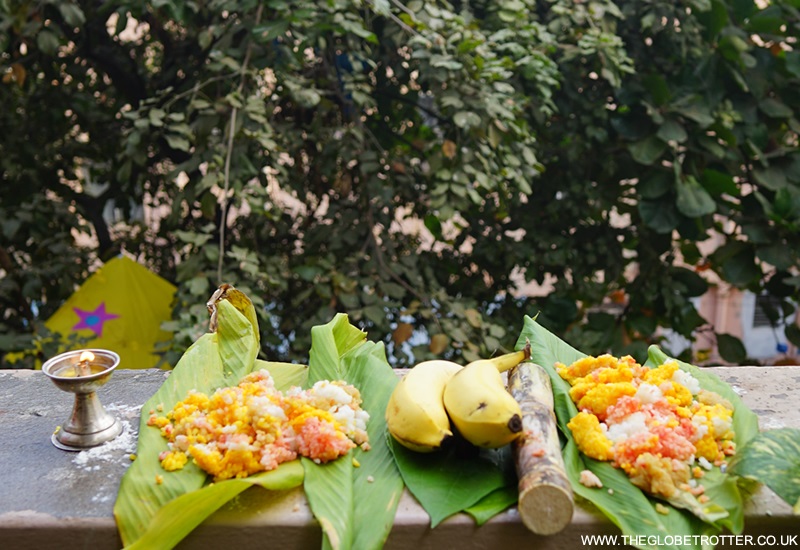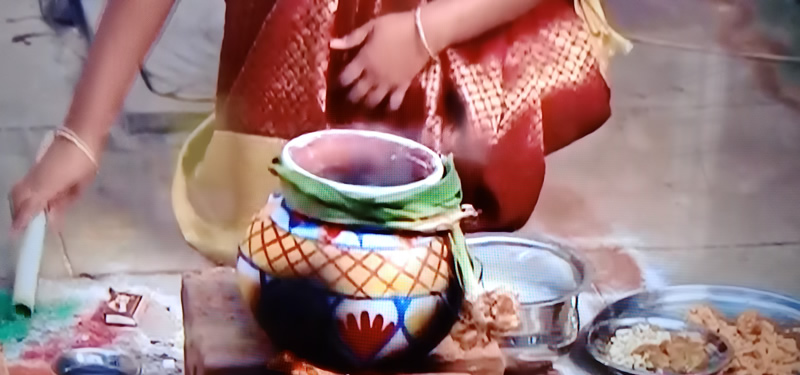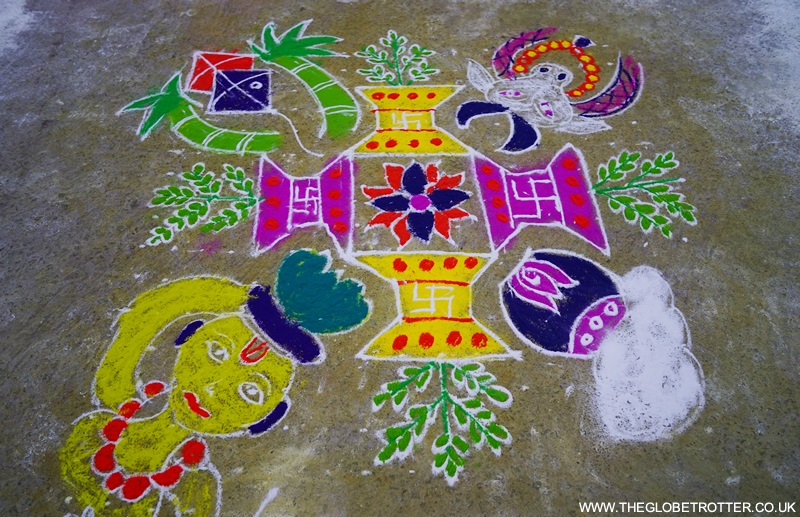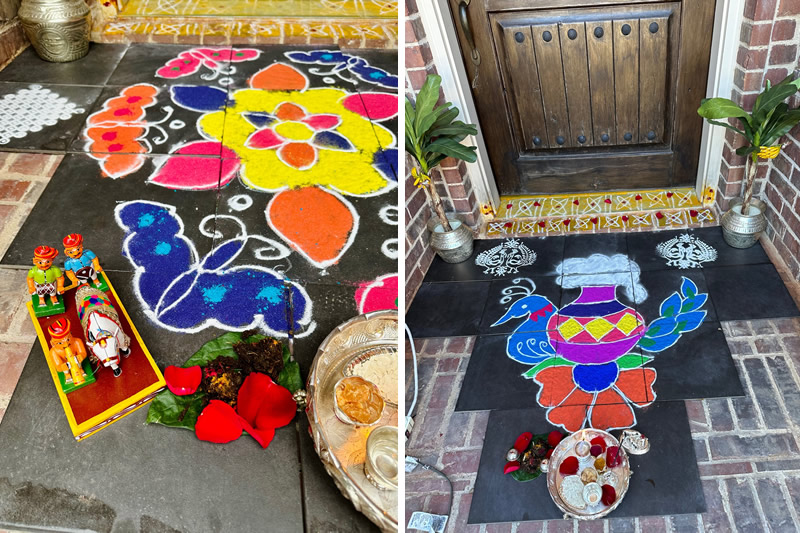The Festival of Pongal in Tamil Nadu
India is a land of diverse cultures and this diversity is reflected in the multitude of festivals celebrated across the country. There are some festivals that are common across the entire country and then each state has its own unique set of festivals as well, adding vibrant colours and flavours to the cultural tapestry of India.
Yaoshang is a Manipuri festival with folk dances, sports, and cultural events while Chhath Puja is dedicated to the Sun God, and celebrated with fasting and rituals in the state of Bihar. Arunachal Pradesh celebrates Losar (Tibetan New Year), Gujarat celebrates Navratri and Garba (a 9-night festival celebrating the divine feminine), Odisha celebrates the Rath Yatra (grand chariot procession of Lord Jagannath) and Tamil Nadu celebrates Aadi Perukku, Karthigai, Puthandu (Tamil New Year), Navaratri (with the traditional Bommai Golu) and Pongal.
Pongal is the harvest festival celebrated in Tamil Nadu and by the Tamil diaspora across the world. It is also called as 'Thai Pongal' by some ('Thai' is the name of the Tamil calendar month in which Pongal takes place). The festival usually takes place in mid-January and marks the end of the winter solstice and the onset of the harvest season.
Pongal is not just a harvest festival but also a way of expressing gratitude to nature, the Sun God (Surya), and the farm animals that play a crucial role in agriculture.
Four Days of Pongal
The name 'Pongal' is derived from the Tamil word 'pongu' which means to 'to boil over'.
During the festival, the traditional dish of 'Chakarai Pongal' is prepared from the new harvest of rice boiled in milk with jaggery and offered to God Surya. The sweet dish is allowed to boil over from the pot, signifying the abundance of the harvest and the prosperity of the coming year.
Pongal is typically a 4-day festival, with each day having its own significance. Some celebrate all the 4 days while some celebrate it on three days. At our home, we celebrate it on three days out of the four.
Bhogi Pongal
'Bhogi' is the first day of Pongal. It is the day when old household items that are no longer in use/no longer needed are discarded. In villages and rural areas, bonfires are lit using these discarded items. These bonfires are called 'Bhogi Manta'. This is said to signify a fresh new start. In urban areas, you may not see these bonfires as much as in rural areas.
Houses are thoroughly cleaned and decorated with flowers and 'Kolam' (colourful art, see below). Those celebrating wear new clothes and seek blessings from their deities for prosperity and well-being.
Surya Pongal
The second day is the main day of the festival and is called as 'Surya Pongal' or 'Thai Pongal' or 'Sankranthi'.
This day is to honour the Sun God, Surya. Without Surya’s energy, agricultural activities wouldn’t be possible. And that is why this day is dedicated to him.
On this day, 'Chakarai Pongal' is prepared. It is first offered to the deities as 'prasadam' and then the family enjoys it. It is also shared with neighbours and friends.
Mattu Pongal
Mattu Pongal is the third day of the festival. 'Mattu' means bull in Tamil language and this day is dedicated to honouring and expressing gratitude to the cattle, particularly cows and bulls, for their role in agricultural activities.
This day is celebrated with great enthusiasm in villages and to a lesser extent in large cities. This is simply due to the fact that rural societies are agrarian societies and cows and bulls are essential for ploughing fields, transporting goods, and providing dairy products. Villagers often participate in various events to honour their livestock.
On this day, cattle are bathed, adorned with garlands, bells and other traditional accessories. Their horns are painted in vibrant colours. This is a way of expressing gratitude to these animals for their invaluable contribution to agriculture. Cattle are considered sacred in Hinduism, and their well-being is vital for a prosperous harvest.
In addition to the festivities and decorations, special meals are prepared for the cattle. The owners feed them a mixture of the freshly harvested grains and Pongal dish as a way of sharing the bounty of the harvest with these animals.
Mattu Pongal is not only about showing gratitude to cattle but also about engaging in festive activities. Traditional games, competitions, and events are organised, bringing communities together.
Kanu Pongal
The fourth day, Kanu Pongal, is a day for family and social gatherings. While the exact customs and traditions vary from region to region and between families, traditionally this is a day when women pray for the well-being of their brothers.
At our home, we prepare a variety of coloured rice balls using boiled rice mixed with turmeric and vermillion and leftover Chakarai Pongal. These balls are then placed on turmeric leaves (in the outdoors) along with betel leaves, betel nuts and sugarcane pieces as offerings to birds.
As we place these balls on the leaves, we say 'Kakapudi vechhai, Kanupudi vecchai, Kaka-kon kuruvi-kon kalyanam'. At the same time, we pray for the well-being of our brothers.Icons of Pongal
Several symbols and icons are associated with the festival of Pongal. Here are some of the important ones.
The Pongal Pot (Pongal Paanai)
The Pongal Paanai is a traditional earthen pot that is used for cooking the special dish called 'Pongal'.
The pot is typically made of clay or earthenware, which is known for its heat-retaining properties. It is designed to withstand high temperatures, making it suitable for cooking the Pongal dish.
The pot is traditionally decorated with turmeric and kumkum (vermilion) on the outside. These decorations not only add a festive touch but also hold cultural and religious significance.
The size of the pot can vary, but it is generally chosen based on the quantity of Pongal that needs to be prepared. During the cooking process, it is common for the pot to be filled to the brim, symbolising abundance and prosperity. Also, one of the central rituals during Pongal is the act of allowing the Pongal dish to boil over or overflow from the pot. This symbolises prosperity and is considered an auspicious sign, indicating a good harvest and abundance in the coming year.As the Pongal Pot overflows, people shout 'Pongalo-Pongal' wishing for good fortune in the coming year.
The Pongal Paanai is not just a cooking utensil; it holds cultural and spiritual significance too. It is a symbol of the agrarian way of life, connecting people to the earth, the harvest, and the divine forces that are believed to bless the land with fertility.
Pictured below is the Pongal Paanai from our home. It is made of stainless steel and since we do not have the facility to cook in the outdoors, my mother does it indoors in the kitchen.
Cow
In Hinduism, the cow holds significant symbolism and is revered as a sacred animal. The symbolism associated with the cow is multifaceted. It is considered as a motherly figure, a source of abundance, a symbol of innocence and nurturing. When you think of Pongal and the cow the association is because of agriculture. Cows are closely related to the rural life in India and to agriculture. They are symbols of prosperity and fertility because of their contribution to farming (by their use in ploughing fields and the use of their dung as fertiliser).
Sugarcane
Sugarcane is one of the major crops that is harvested during the time of Pongal and hence its association with the festival. It is said to symbolise the abundance of crops and the prosperity that comes with a successful harvest. Sugarcane is sweet, and its inclusion in Pongal celebrations is symbolic of the hope for sweetness and good fortune in the coming year. Plus, it is also used as feed for cattle who play a crucial role in traditional agricultural practices. So, we can say that the association of sugarcane with Pongal goes beyond its material significance as a crop; it carries cultural, social, and spiritual connotations as well.
Kolam
Kolam is a traditional Indian art form in which intricate patterns and designs are created on the ground. This art form is practised throughout India and is known by different names in different regions (e.g. Kolam in Tamil Nadu, Muggu in Telangana, Alpana in West Bengal, Chowkpurana in Uttar Pradesh).
Traditionally, Kolam is created using rice flour/paste but people also make use of coloured powders, flowers etc.
In many Indian households, the ladies create Kolam every day at the entrance of their homes or in the courtyards. However, during celebrations and festivals like Pongal, elaborate Kolams are created as they are considered auspicious and believed to bring positive energy to the surroundings.Kolam designs can range from simple designs to intricate, detailed artwork often with geometrical and symmetrical art or in some cases can be freehand motifs inspired by nature, such as flowers, birds, etc.
In Tamil Nadu, a popular form of kolam is the Pulli Kolam (dotted kolam). 'Pulli' in Tamil refers to dots or points, and the designs are created by connecting these dots with lines to form intricate patterns. Pulli Kolams often exhibit a high degree of symmetry and the final design is balanced and visually appealing. The designs in Pulli Kolam can be geometric, floral, or a combination of both.
Popular motifs include flowers, birds, lamps, and other traditional symbols. The choice of design often depends on the occasion and the artist's creativity. For. e.g. during Pongal, you will see symbols like sugarcane, flowers, a pot with pongal overflowing etc. incorporated within the kolam design.Sreevani Gudiseva, who is an Indian expat, usually plans her Kolam designs a week ahead of time, practicing it and deciding on colour choices as well. Pictured below are two of her Kolam designs, both of them featuring Pongal related icons like the bull and the Pongal Pot. Beautiful, aren't they?
Sun
In Hinduism, the Sun is not only a celestial body but also a powerful deity symbolising light, life, knowledge and divine energy. The Sun is personified as the god Surya, who is considered the source of light, warmth and life. The worship of Surya is deeply ingrained in Hindu culture and traditions, influencing various aspects of daily life and religious practices.
The rituals and traditions associated with Pongal express gratitude to the Surya for the successful harvest and mark the beginning of a new agricultural cycle as well. Be it the rituals, the Kolams or even the food prepared for Pongal, you will find a link to Surya (Sun) in everything. You can say that in a way it is the celebration of the interconnectedness of human life with the cycles of nature.
Thoranam
Thoranam is a decorative, hanging archway that is added to doors or entrances during festivals like Pongal to add a festive and celebratory touch. They also serve as a symbolic gateway and are said to bring positive energy and vibes.
Traditionally Thoranams are made with natural materials like mango leaves, coconut fronds, varieties of flowers, leaves, bamboo shoots etc. However, you will also find modern variations using man-made materials that are more durable and long lasting.
If you happen to visit India during any festival, you will notice that most houses have a Thoranam of some sort.Delicacies of Pongal
As kids, one of the major attractions for us during Pongal was that we got to enjoy a special dish also called 'Pongal'.
There are two main types of Pongal dishes made during the festival - Chakarai Pongal (Sweet Pongal) and Venn Pongal (Savoury Pongal).
Traditionally, both the types of pongal were made in an earthenware pot called the Pongal Paanai. The process of cooking Pongal in the Pongal Paanai is a communal activity, often involving family members who gather around to witness and participate in the festivities.
Venn Pongal is a savoury version of Pongal made with rice and lentils (usually split yellow moong dal). The dish is seasoned with black pepper, cumin and ghee (clarified butter), giving it a rich and aromatic flavour. It is often garnished with cashews and curry leaves. Modern variations sometimes include vegetables like green peas.
Chakarai Pongal is the sweet version of Pongal made with rice and jaggery (a type of unrefined sugar made from concentrated sugarcane juice). It is often flavoured with cardamom, ghee, and often garnished with cashews and raisins. Chakarai Pongal is a symbol of prosperity and is offered to the deities as part of the festival rituals.
I am sharing the recipe of Chakarai Pongal that we make at home.
Ingredients- 1 cup rice
- 1/2 cup split yellow moong dal
- 2 cups jaggery (grated or broken into small pieces)
- 1/2 cup + 2 tbsp ghee (clarified butter)
- 1/4 cup cashews and/or raisins (for garnishing)
- 4-5 green cardamom pods (crushed)
- A pinch of edible camphor (optional, for flavour)
Method
- Wash the rice and dal (lentils) together under running water.
- In a pressure cooker, add 2 tbsp ghee and fry the rice and lentils slightly.
- Next, add 4 - 4.5 cups of water and cook the rice and lentils until they are soft and mushy. This would be around 4-5 whistles.
- Once cooked, let it rest for some time. Open the cooker carefully and mash the mixture well.
- In a separate pan, heat ghee. Fry the cashews and raisins until they turn golden brown. Remove them from the ghee and set aside.
- Add the crushed cardamom pods to the remaining ghee and fry for a few seconds until aromatic. Transfer this to a small bowl and set aside.
- Next, in the same pan, add the jaggery with a little water (just enough to immerse the jaggery, around 1/2 cup) and melt it over medium heat. Strain to remove impurities.
- Add the jaggery syrup to the mashed rice and lentils. Mix well to combine. Cook this mixture on low heat, stirring frequently until it thickens.
- Once the pongal thickens, add the ghee (with cardamom), fried cashews and raisins to the Pongal mixture. Mix well.
Pro tip: My mother adds a tiny pinch of edible camphor to Chakarai Pongal for extra flavour. If you can source it, you can try adding this. Just be cautious as camphor is strong, and only a tiny amount is needed.
That's it. Your Chakarai Pongal is ready to be served!
Note: You can adjust the sweetness and ghee content according to your taste.
Related Festivals
Several festivals in India are similar to Pongal in the sense that they celebrate harvest, abundance and gratitude towards nature.
In many states of India, the festival is simply referred to as Makar Sankranti (or Sankranti). The state of Assam celebrates it as Magh Bihu, Gujarat calls it Uttarayana, West Bengal refers to it as Poush Sangkranti while Haryana, Himachal Pradesh & Punjab call it Maghi.
In most parts of India the festivities last between 1-4 days and are marked with colourful decorations, rituals, bonfires, delicious feasts and a joyous atmosphere. If you are travelling to India during the month of January, then do not miss the Pongal (Sankranti) celebrations. It is a wonderful way to experience the unique customs, rituals and festivities associated with the festival and to get a glimpse of the rich cultural tapestry of the country.












Post a Comment